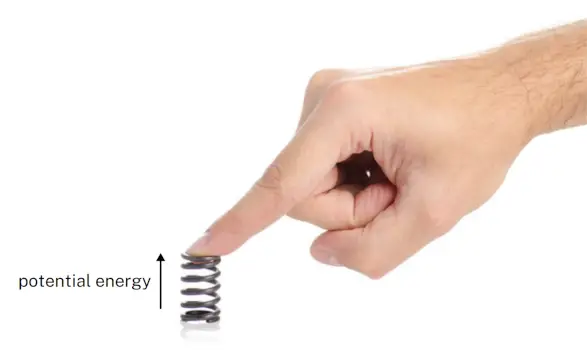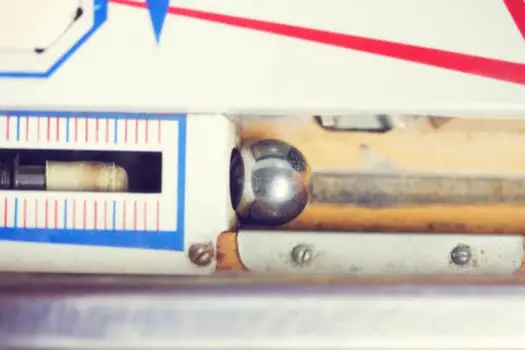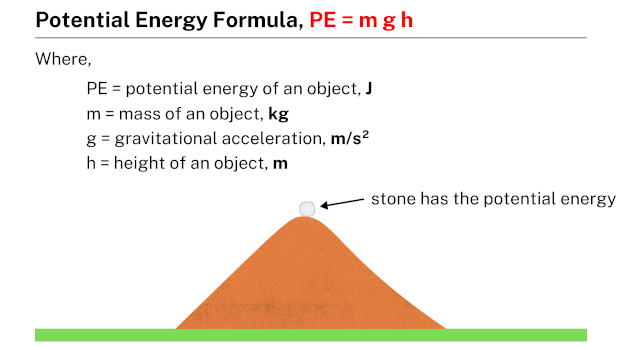Potential energy is the energy stored in an object due to its position or state. It can exist in various forms like gravitational potential energy, elastic potential energy, and chemical potential energy. The amount of potential energy an object has is determined by its position relative to other objects or reference points. When the object changes its position, this stored energy can be transformed into other forms, such as kinetic energy, as the object moves.
Examples
Spring

A compressed spring holds potential energy as a result of its deformation. This potential energy is stored within the spring, ready to be released when the spring is allowed to return to its original, undeformed state. The amount of potential energy is directly proportional to the degree of deformation, showcasing the dynamic relationship between the spring’s compression and its potential to perform mechanical work once released.
Inflated balloon

The stretched rubber of an inflated balloon contains potential energy, as it stores the energy derived from the applied force used to stretch it. This potential energy is a result of the elastic properties of the rubber, which allow it to deform and store energy temporarily. The more the rubber is stretched, the greater the potential energy it holds. When released, this stored energy is converted into kinetic energy, causing the balloon to snap back to its original shape.
Rock

The potential energy within a rock perched at the edge of a cliff is a result of its elevated position above the ground. This potential energy is gravitational in nature, as the rock has the stored ability to do work due to its height relative to the ground. The higher the rock is above the ground, the greater its potential energy. This stored energy becomes evident when the rock is allowed to fall, as it converts its potential energy into kinetic energy, accelerating towards the Earth under the influence of gravity.
Stretched bow

The potential energy in the stretched string of a bow is a result of its displacement from its equilibrium position. When the bowstring is drawn back, work is done against its natural state of rest, storing potential energy in the form of elastic potential energy. The more the string is stretched, the greater the potential energy stored. This stored energy is ready to be transformed into kinetic energy when the arrow is released, propelling it forward.
Hanging fruit

The potential energy within a fruit hanging on a tree branch is a consequence of its elevated position above the ground. This potential energy is gravitational, as the fruit possesses stored energy due to its height. The higher the fruit is suspended from the ground, the greater its potential energy. This stored energy becomes evident when the fruit falls, as gravity acts on it, converting its potential energy into kinetic energy as it descends.
Wrecking ball

The potential energy within a wrecking ball is a result of its elevated position above the ground. This potential energy is gravitational, as the ball holds stored energy based on its height. The higher the wrecking ball is lifted, the greater the potential energy it possesses. This stored energy is significant in demolition scenarios, where the wrecking ball is released to swing and transfer its potential energy into kinetic energy, delivering a powerful impact.
Snow

The potential energy in the snow on a snow-capped mountain is a consequence of its elevated position and gravitational potential. The snow, situated at a higher altitude, possesses stored energy that is directly proportional to its height above a reference point. This potential energy becomes apparent when the snow descends, as gravity acts on it, converting potential energy into kinetic energy. The mountainous terrain serves as a natural example of the relationship between gravitational potential energy and the vertical position of an object, in this case, the potential energy inherent in the snow.
Roller coaster

The potential energy within the wagon of a roller coaster is a result of its elevated position on the track. This potential energy is gravitational, as the wagon holds stored energy due to its height relative to a reference point, often the ground. The higher the wagon is positioned on the track, the greater its potential energy. This stored energy becomes crucial during the ride, as the wagon descends, converting potential energy into kinetic energy, propelling the roller coaster forward.
Water

The potential energy is stored in the water of dams and reservoirs, a result of its elevated position above a reference point. This potential energy is gravitational, as the water holds stored energy due to its height relative to the ground. The greater the volume of water and the higher its elevation, the more potential energy it possesses. This stored energy becomes vital in hydropower generation, where the water is released to flow downhill, converting potential energy into kinetic energy and then into electrical energy through turbines.
Pendulum

The potential energy resides in the pendulum bob, stored as a result of its displacement from its equilibrium position. This potential energy is gravitational in nature, and the farther the pendulum bob is pulled from its resting position, the greater the potential energy it holds. The stored energy is released as the pendulum swings back and forth, with the highest point of the swing representing the maximum potential energy.
Bullet

The potential energy is contained in a bullet before it is fired from a gun, stored due to its position in the chamber. This potential energy is a result of the bullet’s elevated position within the gun, ready to be released when the trigger is pulled. The stored energy is then converted into kinetic energy as the bullet is propelled out of the gun barrel, demonstrating the potential energy inherent in the bullet’s position before firing.
Elastic band

The potential energy is stored in a stretched elastic band, a result of its deformation from its original shape. This potential energy is elastic in nature, arising from the work done to stretch the band. The more the band is stretched, the greater the potential energy it holds. This stored energy is released when the band is allowed to return to its original shape, showcasing the connection between the deformation of an elastic material and the stored potential energy ready to be utilized.
Pinball

The potential energy is present in the pinball of a pinball machine, stored based on its displacement from its equilibrium position when launched. This potential energy is gravitational, as the pinball holds stored energy due to its height above the playing surface. The higher the pinball is launched, the greater its potential energy. The stored energy is then converted into kinetic energy as the pinball descends, illustrating the connection between gravitational potential energy and the vertical displacement of the pinball during its launch.
TV

The potential energy in a TV hanging on the wall is based on its elevated position above the floor. This gravitational potential energy is determined by the height of the TV above the reference point. When the TV is moved or falls, this stored potential energy is converted into kinetic energy as gravity pulls it downward.
Bungee cord

The potential energy in a stretched bungee cord is due to its displacement from its resting length. This elastic potential energy is a result of the work done to stretch the cord. The greater the displacement, the more potential energy is stored. In activities like bungee jumping, this stored energy is converted into kinetic energy as the person jumps, leading to a controlled descent before the bungee cord recoils.
Lantern

The potential energy in a lantern hanging on a rope is associated with its height above the ground. This gravitational potential energy is a consequence of the lantern being suspended above a reference point. The higher the lantern is raised, the greater its potential energy. When the lantern is lowered or falls, gravity acts on it, converting potential energy into kinetic energy as it descends.
Skateboard

The potential energy in the wheels of a skateboard before skating is linked to their elevated position. This gravitational potential energy arises from the wheels being above a reference point, and the greater the height, the more potential energy they store. When the skateboard is in motion, this stored energy is converted into kinetic energy as the wheels move, propelling the skateboard forward.
Formula

The potential energy formula, PE = m g h, establishes a relationship between the potential energy (PE) of an object, its mass (m), gravitational acceleration (g), and height (h). By utilizing this formula, one can calculate the amount of potential energy stored in an object based on its mass, gravitational acceleration, and height.
Practice problems
Problem #1
Calculate the potential energy of a 1.5 kg book that is about to fall from the top of a 2.65 m bookshelf. Assume a gravitational acceleration value of g = 9.8 m/s2.
Solution
Given data:
- Potential energy of a book, PE = ?
- Mass of a book, m = 1.5 kg
- Height from which a book is about to fall, h = 2.65 m
- Gravitational acceleration, g = 9.81 m/s2
Applying the formula:
- PE = m g h
- PE = 1.5 × 9.81 × 2.65
- PE = 38.99 J
Therefore, a book has the potential energy of 38.99 J, before it falls from the top of a bookshelf.
Problem #2
A stone with a mass of 4 kg is resting at the edge of a hill that has a height of 50 m. Calculate the potential energy of the stone right before it falls off the hill. Use a gravitational acceleration value of g = 9.8 m/s2.
Solution
Given data:
- Mass of a stone, m = 4 kg
- Height from which a stone is about to fall, h = 50 m
- Potential energy of a stone, PE = ?
- Gravitational acceleration, g = 9.81 m/s2
Applying the formula:
- PE = m g h
- PE = 4 × 9.81 × 50
- PE = 1962 J
Therefore, a stone has the potential energy of 1962 J, right before it falls off the hill.
Problem #3
Determine the potential energy of a 500 g fruit hanging from a tree branch that is about to fall from a height of 2 m. Consider a gravitational acceleration value of g = 9.8 m/s2.
Solution
Given data:
- Potential energy of a fruit, PE = ?
- Mass of a fruit, m = 500 g = 0.5 kg
- Height from which a fruit is about to fall, h = 2 m
- Gravitational acceleration, g = 9.81 m/s2
Applying the formula:
- PE = m g h
- PE = 0.5 × 9.81 × 2
- PE = 9.81 J
Therefore, a fruit hanging from a tree branch has the potential energy of 9.81 J.
Problem #4
A monkey weighing 10 kg is sitting on the edge of a wall and is about to jump from a height of 4 m. Calculate the potential energy of the monkey. Take the gravitational acceleration value as g = 9.8 m/s2.
Solution
Given data:
- Mass of a monkey, m = 10 kg
- Height from which a monkey is about to jump, h = 4 m
- Potential energy of a monkey, PE = ?
- Gravitational acceleration, g = 9.81 m/s2
Applying the formula:
- PE = m g h
- PE = 10 × 9.81 × 4
- PE = 392.4 J
Therefore, a monkey sitting on the edge of a wall has the potential energy of 392.4 J.
Related
More topics
- Thermal energy
- Potential energy
- Kinetic energy
- Chemical energy
- Electrical energy
- Geothermal energy
- Radiant energy
- Sound energy
- Elastic energy
- Gravitational energy
- Mechanical energy
- Electric potential energy
- Rotational energy
- Photon energy
External links
- https://sciencenotes.org/what-is-potential-energy-potential-energy-examples/
- https://www.solarschools.net/knowledge-bank/energy/forms/potential
- https://examples.yourdictionary.com/examples-of-potential-energy.html
- https://www.britannica.com/science/potential-energy
- https://www.physicsclassroom.com/class/energy/Lesson-1/Potential-Energy
- https://www.studysmarter.us/explanations/physics/energy-physics/potential-energy/
- https://www.khanacademy.org/science/ms-physics/x1baed5db7c1bb50b:energy/x1baed5db7c1bb50b:potential-energy/a/potential-energy
Deep
Learnool.com was founded by Deep Rana, who is a mechanical engineer by profession and a blogger by passion. He has a good conceptual knowledge on different educational topics and he provides the same on this website. He loves to learn something new everyday and believes that the best utilization of free time is developing a new skill.
